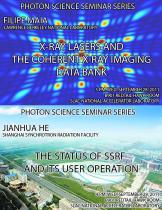Speakers: Filipe Maia (Lawrence Berkeley National Laboratory), Jianhua He (Deputy Director, Shanghai Synchrotron Radiation Facility)
X-ray Lasers and the Coherent X-ray Imaging Data Bank (Filipe Maia, 3:00pm)
X-ray lasers, which are many times brighter and have a much shorter pulse duration that previous sources, have opened up a large range of new experiments. Another important characteristic is their high repetition rate. This has created a very large volume of experimental data from such sources. For example the CXI beamline at LCLS would produce 10x more data than the ATLAS detector at LHC during one year of continuous operation. The Coherent X-ray Imaging Data Bank is an online repository of experimental data, unified under a single file format, designed to address this problem. It allows the community to share and organize their data as well as distribute the burden of data analysis through a large community, effectively speeding the rate of discovery.
The Status of SSRF and its user operation (Jianhua He, 4:00pm)
The Shanghai Synchrotron Radiation Facility (SSRF) is a third generation light source of 3.5GeV electron energy and provides very brilliant X-ray and soft X-ray beams. Seven beamlines have been built at SSRF as the phase I beamlines:
1) Macromolecular Crystallography Beamline
2) X-ray Absorption Fine Structure Beamline
3) X-ray Diffraction Beamline
4) Hard X-ray Microprobe Beamline
5) X-ray Imaging and Biomedical Applications Beamline
6) Small Angle X-ray Scattering Beamline
7) Soft X-ray Spectromicroscopy Beamline
The construction of SSRF was completed by April of 2009 and its user operation began from May of 2009. Since then, it has received about 1600 user proposals and 6800 user visits. The research fields of user experiments include life sciences, material sciences, environmental sciences, physics, chemistry, medical and industrial applications etc.. Especially, the research in fields of structural biology, chemical catalyst and medical applications is very active and productive as well. Both the status of user operation and some research highlights will be introduced briefly in this talk.
At present, research in protein sciences is one of the scientific focuses at SSRF. Five new beamlines for protein sciences are under construction now and are scheduled to be completed by the end of 2013. Besides, a proposal of SSRF Phase II project is under discussion, in which 24 beamlines have been proposed in order to make full use of the potential of SSRF and to meet the rapidly increasing demand. A brief introduction of future programs at SSRF will be given in this talk.





